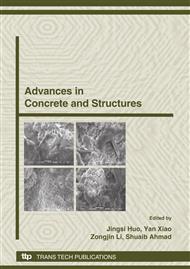p.911
p.917
p.923
p.929
p.935
p.943
p.949
p.957
p.963
A Computer Simulation-Based Method for the Volume Fraction of Capillary Pores
Abstract:
In view of the importance of capillary pores to the physiomechanical properties of cement-based materials, it is essential to determine the volume fraction of capillary pores. The intention of this paper is to present a computer simulation-based method for predicting the volume fraction of capillary pores. By applying the periodic boundary conditions and introducing three physical parameters to quantify the mutual interference between neighboring cement particles, a computer simulation technique for the distribution and hydration of cement particles is described. Based on the simulated microstructure of cement paste, a numerical method is developed for the volume fraction of capillary pores. After verifying the numerical method with the experimental results obtained from the research literature, the effect of the water/cement ratio and the maximum cement diameter on the volume fraction of capillary pores is evaluated in a quantitative manner. It is found that, at a given hydration time, the volume fraction of capillary pores increases with the increase of the water/cement ratio and/or the maximum cement diameter. This paper concluded that the developed numerical method can predict the volume fraction of capillary pores with reasonable accuracy.
Info:
Periodical:
Pages:
957-962
Citation:
Online since:
October 2008
Authors:
Price:
Сopyright:
© 2009 Trans Tech Publications Ltd. All Rights Reserved
Share:
Citation:


